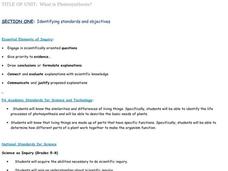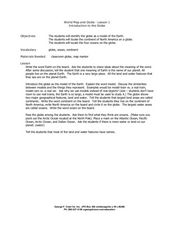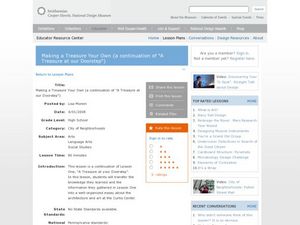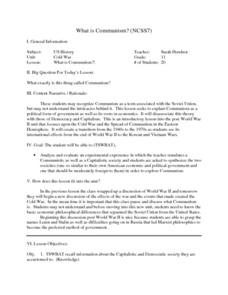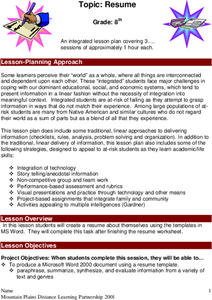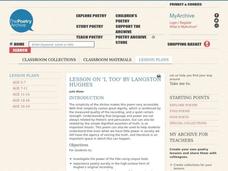Curated OER
Will it SINK or Float?
Students predict whether objects will sink or float in water. They classify objects as sinking or floating in water. Students identify and explain similarities between objects that sink and float.
Curated OER
What is Photosynthesis?
Students investigate the similarities and differences of living things. Specifically, students will be able to identify the life processes of photosynthesis and describe the basic needs of plants.
Curated OER
World Map and Globe - Lesson 1 Introduction to the Globe
Students explore the earth with maps and globes. For this map lesson, students use maps and globes to locate oceans and continents.
Curated OER
Stories Aren't Always What They Seem; Or Are They?
Students draw conclusions about a story with examples to support their statements. In this reading comprehension lesson, students look at a PowerPoint of a variety of passages from different books. They answer questions about the...
Curated OER
Making a Treasure Your Own: Lesson Two
High schoolers write an essay describing the Curtis Center and what they learned there. In this descriptive writing essay, students discuss the five paragraph essay and review sensory discoveries from their trip. High schoolers draft an...
Curated OER
Equivalent Fraction Licorice
Students discuss the meaning of "equivalent" and look for similarities in a bag of pre-cut licorice given to their group. In this math instructional activity, students experiment with making equivalent pieces of licorice from other...
Curated OER
Analogies In Action
Students practice skills to determine the relationship of words. In groups of two, classmates complete a chart to match vocabulary words into specific groups such as synonyms, antonyms, or familial relationship. To reinforce word...
Curated OER
Investigation: The Local Bagel Shop
Sixth graders explore economics by solving business math problems. In this ratio and proportion instructional activity, 6th graders examine different meals to be purchased at a coffee shop and compare which prices make which meals a...
Curated OER
Homophone Jeopardy
Students are introduced and practice using words classified as homophones. Individually, they participate in a Jeopardy game in which they practice using different sets of homophones in sentences. They discuss the different situations...
Curated OER
Global Literature: Nectar In A Sieve
Students write a persuasive essay explaining how religion and/or spirituality serves as both a guide and a source of conflict for both an individual and their culture. They develop a definition for the terms spiritual and religious...
Curated OER
Friendship
Students investigate the concept of friendship with the help of two different quotations. The quotations are used to compare and contrast two facets of friendship and what is needed to encourage fruitful relationships. They read "The...
Curated OER
Bivalve or Univalve (Clam or Snail)?
Fourth graders explore the meaning of the prefixes "bi" and "uni." In groups, 4th graders observe pictures of shells and handle real shells. Students create a chart to classify each shell as a bivalve or univalve. They identify the...
Curated OER
Gandhi's Voice: Writing as Nonviolent Resistance
Ninth graders identify how Mahatma Gandhi used writing as a means of nonviolent communication. For this nonviolent resistance lesson, 9th graders watch a film about Gandhi as a writer and identify characteristics of nonviolent activism....
Curated OER
No Title
Third graders explore the role of music in a variety of situations including life experiences, celebrations, functions and special events. They also identify ways in which the principles and disciplines taught in school are interrelated...
Curated OER
Developing Cultural Awareness through Mexican Folktales
Learners explore the culture of Mexico through folktales. They identify cultural differences and similarities through the reading of folktales. Students create pocket books related to Mexican folklore. They read and discuss literary...
Curated OER
Lexis: changing attitudes
Learners notice lexical items as chunks of language. They use grammar of multi words and are introduced to a lexical set connected to money. Students are given a chance to peer teach. They are encouraged to use dictionaries.
Curated OER
What is Communism?
Eleventh graders explore Communism. They explore Communism's roots in economics and discuss the spread of Communism in the Eastern Hemisphere. They evaluate a Communistic and a Capitalistic society. Students reflect upon the positives...
Curated OER
How is Rice Used in Food from Different Cultures?
Fifth graders examine how rice is used in different cultures. In this culture activity, 5th graders explain the similarities between dolmas and sushi, then name two different Mexican rice dishes. Students learn new vocabulary words,...
Curated OER
What's That Habitat?
Fourth graders explore the environment by researching animal characteristics. For this habitat identification lesson, 4th graders utilize paper and crayons to illustrate their own habitats or homes and discuss what it contains that is...
Curated OER
Resume
Students create a resume for themselves using a Microsoft Word template. Students view and evaluate sample resumes and complete a worksheet to determine the information they should include in the resume they complete for themselves.
Curated OER
Read the Directions
In this comprehension worksheet, 5th graders focus on following written directions. Students seek out and circle specific "direction" words in the 11 sentences given.
Curated OER
Remembrance Day
Second graders research the meaning behind Remembrance Day. In this Remembrance Day instructional activity, 2nd graders discuss peace and why Remembrance Day is significant. The book Why We Remember is read aloud to the students.
Curated OER
The Poetry Archive
Students investigate the power of title and poetry in a Langston Hughes' poem. In this poetry analysis lesson, students discuss the poem 'I, Too' for its title and content. Students use the variation in English Words and Phrases website...
Curated OER
Guzzinta
Learners explore strategies to solve number problems. They study divisibility rules. Students examine and practice multiples, factors, and palindromes. In groups, learners play a "number property" game.



